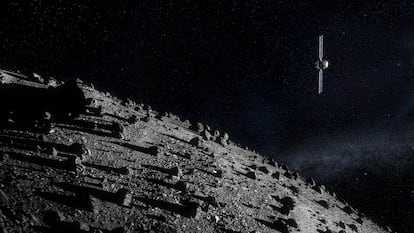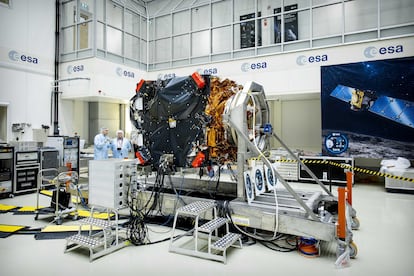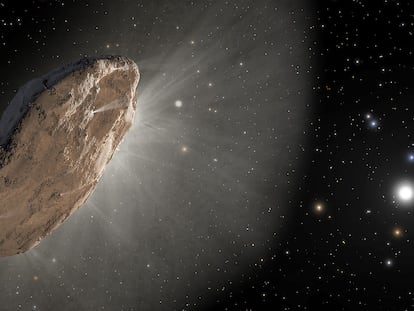European Space Agency set to launch probes at asteroid to test planetary defense system
The Hera mission will study the Dimorphos asteroid that was pushed off course by NASA’s DART spacecraft in 2022


Hera, the mythological Greek goddess associated with marriage, the sky and the stars, is the name of the European Space Agency’s (ESA) first planetary defense mission. Conducted in collaboration with NASA, the Hera mission will explore ways to redirect asteroids to prevent collisions with our planet. Hera will study Dimorphos, the smaller of two objects forming the Didymos binary asteroid system. In 2022, NASA’s DART spacecraft successfully pushed Dimorphos off course, achieving the first intentional human alteration of an object’s orbit in the solar system. Spain’s King Felipe VI plans to visit ESA’s European Space Research and Technology Center (ESTEC) to see the Hera probe during his state visit to the Netherlands.
Dimorphos will be around 195 million kilometers (121 million miles) from Earth when the Hera probe, scheduled for launch on October 7 from Cape Canaveral, reaches its destination. “With a mission like this, the dinosaurs might have been spared from the huge meteorite crash that wiped them out,” said Franco Pérez Lissi, a Spanish systems engineer at ESTEC. Hera, a cube-shaped probe with solar-panel wings, is being built at ESTEC’s facilities in the Dutch town of Noordwijk. ESTEC’s Satellite Test Center is the largest in Europe, and has the capability to simulate every aspect of a launch and the space environment. Pérez said Hera will be rigorously tested, “including the critical separation stage from the SpaceX launcher and for electromagnetic compatibility.”
In 2029, the Apophis asteroid (diameter of 370 meters or 1,210 feet) will pass close to the Earth. “It will be less than 36,000 kilometers [22,370 miles] away, but it won’t crash into us. It will be close enough for people in certain areas to see it, which is why we have detection systems,” Pérez said. The Hera team is already working on a mission called RAMSES that will approach Apophis using technology developed for Hera. Two years ago, the DART probe disintegrated when it collided with Dimorphos, which is 177 meters (581 feet) at its longest. DART, the size of a refrigerator, altered the asteroid’s trajectory by transferring its kinetic energy during the collision. According to Pérez, “we studied using explosives to destroy the asteroid, but found that detonation would disperse a cloud of large rocks rather than alter its trajectory.” That would have been a poor outcome, so this option was discarded.

Hera will enable scientists to closely study DART’s impact on the asteroid to refine future techniques for diverting celestial bodies. Additionally, the data it gathers will enhance our understanding of asteroid composition and structure. Asteroids are rocky objects orbiting the Sun, often found in the asteroid belt between Mars and Jupiter. When these objects survive atmospheric entry and reach the Earth’s surface, they are called meteorites.
Dimorphos orbits Didymus, which is 851 meters (2,791 feet) at its longest. They form a binary system: a big rocky body and a smaller one orbiting around it. Pérez likens it to the Earth and the Moon. “Dimorphos is stuck in a gravitational corridor, spinning around the main body like our Moon.” He says Hera is scheduled to arrive at the end of 2026, “and we want to know if Dimorphos shares any elements with Didymus because it would give us clues about its origin.” It might be another asteroid that crashed long ago, forming this rock held close to Didymus by gravity.

Pérez heads the team designing and testing Juventas and Milani, two space drones carried aboard the Hera. Juventas has a low-frequency radar that will send pulses to study Dimorphos’ composition. It will also use a gravimeter and accelerometer to measure how mechanical equipment will behave in the asteroid’s ultra-low gravity. “We’re curious whether it has a solid core or if it’s just bits of rock from the main asteroid, held together by gravity,” Pérez said. The Milani drone has a hyperspectral camera that enables imaging at different wavelengths. “It does a better job than the naked eye at spotting organic components on the surface, like iron or other minerals.” It will also collect samples of asteroid dust.
During a tour organized for Spanish journalists, Pérez explained that Hera will send data as soon as it’s launched, because the on-board computer will be running and the radios will be on. “We need to get it on the right path, and if all goes smoothly, we’ll hit Mars by March 25. Then, around October 2026, we’ll arrive at the asteroid.” The Hera will take a month to gradually slow down to Dimorphos’ speed before the mission’s nine-month operational phase begins.
Once Hera has synchronized with Dimorphos’ orbit, Juventas and Milani will be deployed. “We’ll take images and attempt to fly really close to the surface with the main ship to collect detailed data. Hera’s guidance, navigation and control system, which was designed by the GMV company in Madrid, will enable us to do this.” Once all the data collection is done, Hera will be guided to a controlled landing on the asteroid. The Hera mission showcases the power of international collaboration, with over 80 companies participating from 17 ESA member countries. The satellite design team will oversee the mission from the European Space Operations Center (ESOC) in Darmstadt, Germany. Another group will be stationed at Cape Canaveral for the launch, which will use a Falcon 9 rocket made by SpaceX. Pérez hopes there will be no launch delays. “If we can’t launch in October, the gravitational maneuvers will take longer. We’d have to head to Mars, swing back to Earth, and then make our way to the asteroid.”
Sign up for our weekly newsletter to get more English-language news coverage from EL PAÍS USA Edition
Tu suscripción se está usando en otro dispositivo
¿Quieres añadir otro usuario a tu suscripción?
Si continúas leyendo en este dispositivo, no se podrá leer en el otro.
FlechaTu suscripción se está usando en otro dispositivo y solo puedes acceder a EL PAÍS desde un dispositivo a la vez.
Si quieres compartir tu cuenta, cambia tu suscripción a la modalidad Premium, así podrás añadir otro usuario. Cada uno accederá con su propia cuenta de email, lo que os permitirá personalizar vuestra experiencia en EL PAÍS.
¿Tienes una suscripción de empresa? Accede aquí para contratar más cuentas.
En el caso de no saber quién está usando tu cuenta, te recomendamos cambiar tu contraseña aquí.
Si decides continuar compartiendo tu cuenta, este mensaje se mostrará en tu dispositivo y en el de la otra persona que está usando tu cuenta de forma indefinida, afectando a tu experiencia de lectura. Puedes consultar aquí los términos y condiciones de la suscripción digital.
More information
Archived In
Últimas noticias
ICE raids trigger school absenteeism and traumatize children: ‘They have been forced to leave their childhood behind’
The guardians of the meteorites of the Argentine Chaco
Helen Levitt, the photographer who captured the theater of the everyday
The life of a delivery driver in China: ‘Many people don’t know how an order can arrive at their home in just one day’
Most viewed
- Christian Louboutin: ‘Young people don’t want to be like their parents. And if their parents wear sneakers, they’re going to look for something else’
- US sanctions against jailed cartel leader ‘El Marro’ highlight Mexico’s lack of control over its prisons
- The low-cost creative revolution: How technology is making art accessible to everyone
- Liset Menéndez de la Prida, neuroscientist: ‘It’s not normal to constantly seek pleasure; it’s important to be bored, to be calm’
- Cartels in Mexico take a leap forward with narco-drones: ‘It is criminal groups that are leading the innovation race’










































